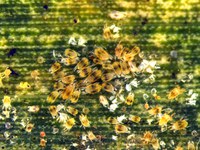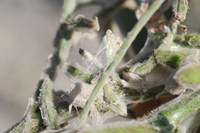Spider Mites Continue to Cause Problems in Some Fields
(Click an image below to view a high-resolution image that can be downloaded)
Spider mites continue to be a pest problem in dry beans, soybeans and field corn in droughty areas.
Spider mites typically infest the edges of a field edge, so producers should scout there first to determine if mites are present.
A quick sampling procedure is to hold a piece of white paper below the leaves and then hit the leaves to dislodge the mites. The mites will appear as tiny dust specks. However, the mites will move after being knocked off the leaf.
Another method is to pull some plants and examine the undersides of the leaves for mites and webbing.
“Soybeans are most susceptible to damage during the full pod (R4) through beginning seed (R5) stages because the yield is being set at the R4 and R5 stages,” says Janet Knodel, North Dakota State University Extension Service entomologist. “However, producers should continue to scout soybeans for spider mites until maturity because they will continue to feed on any green tissue.”
Spider mite feeding reduces the photosynthetic area of the leaves and heightens drought stress. Spider mites can cause reduced pod set, seed number and seed size in soybeans. If spider mites cause leaf drop or kill the plant, pod fill can be stopped. Pods on mite-stressed plants are more likely to shatter, which also compounds yield loss.
“As soybeans get closer to maturity, be sure to observe the preharvest intervals of insecticides, which can vary from 14 to 28 days,” Knodel says.
Field corn is susceptible to spider mite damage from tasseling through the hard dough stage. When the corn has reached the hard dough stage, it is no longer susceptible.
“Our drought conditions stress plants, whether mites are present or not,” Knodel says. “If conditions continue, treating for mites is no guarantee plants will recover because of the drought. In addition, products labeled for mite control often do not give adequate control (less than 80 percent), so mite populations may rebound quickly to pretreatment levels or higher. Recent much-needed rain and humidity in some areas will help slow spider mite infestations.”
A fungal pathogen can help reduce mite populations naturally. Conditions that are good for the development of the pathogen are temperatures cooler than 85 degrees, with at least 90 percent relative humidity for 12 to 24 hours.
NDSU Agriculture Communication - July 27, 2012
| Source: | Janet Knodel, (701) 231-7915, janet.knodel@ndsu.edu |
|---|---|
| Editor: | Rich Mattern, (701) 231-6136, richard.mattern@ndsu.edu |



